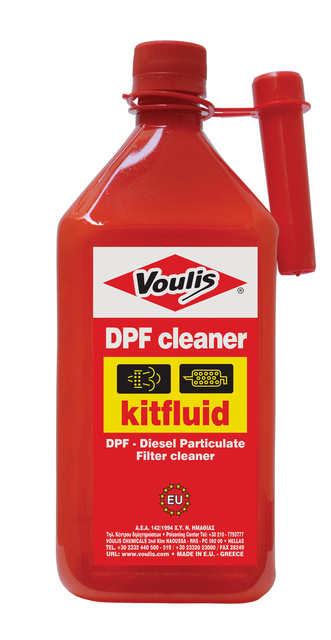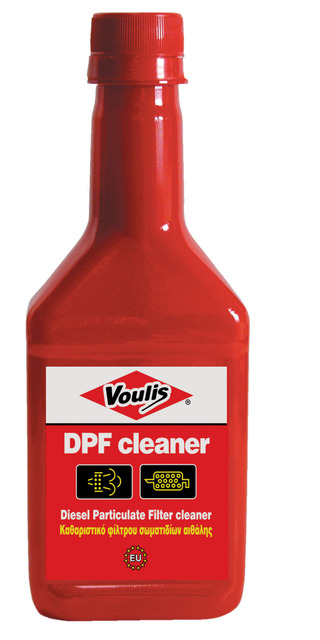DPF CLEANER
Diesel Particulate Filter Cleaner
| Category: | POWER BOOSTERS - INJECTORS CLEANERS |
|---|---|
| Code: | 2.10.022 |
Most European standards (Euro 5 and later) for emissions of diesel cars, greatly limit soot emissions that are a particulate combustion residue. The quantity of soot as a solid residue varies : 1. Depending on the quality of oil (biodiesel greatly increases the levels of soot). 2. Engine oil (appropriately low smoke) . 3. The average speed that a car is driven (in or out of town). 4. By normal wear of the engine and its accessories. In EURO 5 engines and later common rail engines, automakers put a soot particle filter (soot-trap) which is abbreviated by the initials DPF (diesel particulate filter), in order to bind the particles of soot. DPF filters have the ability to retain the soot particles while allowing other gases to leave. Like all filters, though, they eventually clog by the accumulation of particles, and will need to empty the cells retention in order to recover their properties. Several models have a differential pressure sensor, where they measure the pressure when introducing emissions in filter as opposed to the pressure of the exhaust filter, in order to have direct information regardine the load of particulates inside the filter, to start the process of warning with the special lamp, aiming to decongestion and regeneration of the filter. Except replacement there are three main methods to regenerate or renewal the filter. 1. Passive regeneration: This occurs during the course of the car at highway, in order to achieve increased exhaust temperature to burn the soot (soot is burning in over 600 ᵒC). This temperature cannot be achieved at low speeds of a car that moves within a city. For the increase of temperature very helpful is an oxidizing catalyst that several cars have positioned in their system. 2. Active regeneration: automobiles with differential pressure sensor, when realize filling in soot filter (around 45%), automatically trigger adjustments to the injection timing of fuel, so that the exhaust gas enters the filter at a higher temperature and burn soot. 3. Forced regeneration: When despite the effort of passive regeneration, the lamp of DPF failure lights, then the system goes into limb mode (extreme situation). When this happens you should immediately go to a specialized workshop where with the use of a diagnostic they proceed to forced regeneration. What happens if you ignore the lamp failure DPF? Then the regeneration becomes quite difficult to impossible, and the only solution will be the cleaning with specialized equipment or direct replacement of the filter DPF. What can I do to keep the filter DPF in good working condition? Voulis Chemicals in collaboration with reputable companies, developed the product DPF Cleaner which is a liquid additive oil that ensures: 1. Fully compatible to all forms of regeneration. 2. Functionality in a wide temperature range in order to accelerate the time of burning soot. 3. In use, zero residues in the remaining parts of the engine, even in poor quality oil or high biofuel. 4. Significant increase in cetane number. 5. With proper use it prevents long time regeneration, because high temperatures can damage the substrate material of the filters (cordierite, which has a melting point 1200 ᵒC - or silicon carbide having a melting point 2700 ᵒC). Proper use would be to continuously add to the tank ( 1 bottle of 250 ml in 300 lit oil – approximately in 5 tank fillings ) to achieve continuous prevention of soot build-up in the cell collection of the DPF filter. Steps to be taken if the failure lamp of the DPF filter lights: 1. When indicator lamp of the filter DPF lights, then pour the whole bottle (250ml) of DPF cleaner and extrude the engine in form of passive regeneration. We drive for about 30 minutes at a speed of about 60 km / h. Depending on the load of the filter we may need to add a second bottle of DPF cleaner. After app. 100-200km the lamp should turn off. 2. If the light comes back soon or remains lit, then visit a specialized workshop with a special diagnostic device to proceed to forced regeneration, with the support of the PDF cleaner. 3.If it still does not turn off the lamp display and after we make sure that there is no faulty sensor differential pressure, then proceed with a specialized cleaning machine or replacement of the DPF. The diesel PSA (partnership Peugeot - Citroen) and some Ford and Volvo have built an automatic injection system material in the tank for quick and frequent regeneration. There is a separate container embedded in the tank which is filled with the specific additional detergent DPF cleaner KITFLUID formula (1 lit).
 κόκκινο.jpg)

